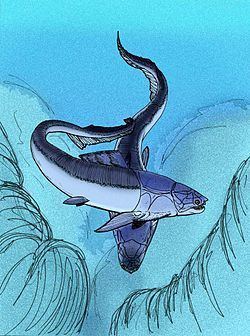Infraphylum Gnathostomata Phylum Chordata | Subphylum Vertebrata Class Placodermi Infraorder Pachyosteomorphi | |
 | ||
Similar Jiuchengia, Neopetalichthys, Goodradigbeeon, Buchanosteus, Minicrania | ||
Xiangshuiosteus wui is a brachythoracid arthrodire placoderm from the Late Emsian epoch of Wuding, Yunnan. It has recently been reassessed as a dunkleosteid.
Contents
Specimen and Taxonomy
X. wui is known from a flattened, "Buddhist cap" shaped skull roof. The skull roof is strongly reminiscent of those of coccosteids, but also has anatomical features otherwise diagnostic of buchanosteids. This mix of anatomy lead its describer, Wang Junqing, to suggest that X. wui is the sister taxon of Coccosteidae, and represents a transitional form between Coccosteidae and Buchanosteidae. A reappraisal of Kiangyousteus and several other eubrachythoracid arthrodire genera by You-An Zhu and Min Zhu lead to the conclusion that X. wui not only does not represent a transitional form between coccosteids and buchanosteids, but is actually a dunkleosteid closely related to the Gogo Reef Eastmanosteus calliaspis (which is, in turn, implied to be not of the genus Eastmanosteus).
Etymology
The generic name literally translates as "Chinese: 香水; literally: "perfume"(Pinyin:Xiāngshuǐ) + bone," but actually refers to Xiangshui Valley, the district in Wuding County where the holotype was found. The specific name honors Wu Baosheng, the gentleman who provided the holotype to Wang Junqing, the species' describer.
